Bat Profiles
An introduction to the bats of Alberta
THE BATS OF ALBERTA
There are over 1300 species of bats worldwide, of which about 19 occur in Canada and about 9 occur in Alberta. Although most of the world’s bat diversity occurs in the tropical and subtropical regions of the world, Alberta’s bats are abundant and are undoubtedly important to the healthy functioning of our ecosystems. Bats found in Alberta can be broadly divided into two major groups based on how they cope with our long, cold Canadian winters. These include 3 species that are long-distance migrants, and at least 6 species that hibernate in the province and are present year-round.
Below you will find a short summary of each species found in the Alberta Community Bat Program’s free guide: Building Bat Friendly Communities.
Long-distance Migratory Bats
While all bats in Alberta are migratory to some extent, three species appear to leave the province altogether—the Hoary Bat, Eastern Red Bat, and Silver-haired Bat. This strategy may reduce the need to accumulate large fat stores to survive the winter, and may help explain why this group typically gives birth to more than one pup. It is largely unknown where our migratory bats overwinter, but it may include the southern US, Mexico, or even the warmer regions of British Columbia. Bats that leave the province for the winter may still hibernate during cold winter weather, albeit for shorter periods.
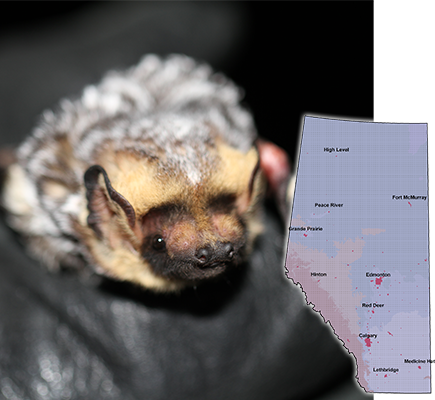
Hoary Bat
(Lasiurus cinereus)
Few bats are as colourful as the Hoary Bat and the Eastern Red Bat (Lasiurus borealis). Hoary bats have a distinctive yellow mane and their cinnamon-coloured coat is frosted with white tips like “hoar-frost”, which is why they were given the name Hoary Bat. Weighing about 35 grams, they are the largest bat in Canada. They are fast, long-distance foragers that typically forage in the open, often along the edges of forests and above the forest canopy. They have a fondness for large moths. Other insects are also eaten depending on what’s available—including beetles and dragonflies. Foraging flights of up to 20 kilometres (plus return) are not uncommon.
The species roosts among the foliage of deciduous or coniferous trees, typically selecting trees that are taller than the surrounding canopy. Their colouration makes them very difficult to see among the foliage of trees. They roost alone, except for mothers roosting with their twin pups. Hoary Bats are long-distance migrants leaving Alberta’s winter behind with flights that may be well over a thousand kilometres. Their migratory behaviour is poorly understood, but they likely overwinter in the southern United States or Mexico, and may undergo periods of hibernation when they reach these locations.
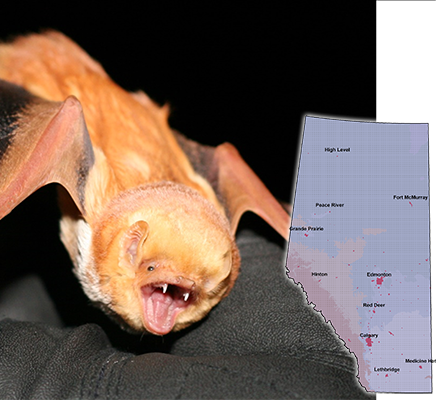
Eastern Red Bat
(Lasiurus borealis)
Eastern Red Bats are medium-sized bats with long, narrow wings for high, fast flights. Like many bats in Alberta, moths are the main component of their diet, but they will eat lots of other insects as well. They are solitary foliage-roosting bats, typically roosting out on the limbs of branches where they are well concealed among clumps of leaves. Mothers roost in the tree canopy with their pups, which may number up to four in the eastern parts of their range (which is an exceptionally large litter size for bats). Almost nothing is known about reproduction by Eastern Red Bats in western Canada, and most observations are of males and non-reproductive females, making it uncertain whether they actually breed in the province.
The species is named for the colour of its fur: males are bright red, females are more of a grey-red. Their fur colour makes them almost invisible among the leaves of deciduous trees. Once believed to be rare vagrants in Alberta, recent studies, particularly as part of oil sands and wind energy projects, have revealed that the species is a common visitor of Alberta’s deciduous forests. This species migrates to warmer climates during the winter, likely in the southeastern United States. During cold winter weather, they may crawl into leaf litter and undergo short periods of hibernation
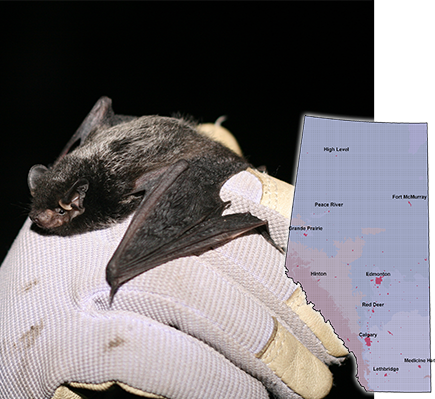
Silver-haired Bat
(Lasionycteris noctivagans)
Silver-haired Bats are among the most common, wide-ranging and easily recognizable bats in Alberta. They are slightly larger than Myotis species, and are typically black except for a silvery frosting to their hair (which varies in its intensity). They are adapted for fast long-distance flights, and forage in the open for moths and other insects. Foraging may occur above wetlands, high in the canopy, or along the edges of forests. Treks of up to 10 kilometres or more are common.
Roosting occurs primarily in the crevices of large diameter decaying trees, but is more variable during migration (common sites include the side of buildings, bat houses, and under patio umbrellas). A variety of structural defects in trees may be used for roosting, and use of old woodpecker holes is common. Suitable hiding spots are most often in deciduous trees (e.g., aspen or balsam poplar) but any suitable tree may be used. Females may produce twins and groups of mothers and pups roost in small groups of up to 35 individuals (often closer to 10).
Silver-haired Bats are long distance migrants, and most appear to leave the province during the winter to find warmer climates. Where Silver-haired Bats from Alberta spend the winter is largely unknown. However, this species has been confirmed to hibernate in southern British Columbia, where they occupy locations such as caves, mines, trees, gaps among tree roots, and wood and rock piles. There is growing evidence that male Silver-haired Bats in southern BC are year-round residents, whereas many of the females are moving in from other locations (possibly including Alberta). Winter bat activity has also been detected in southeastern Alaska [1], suggesting they may hibernate in more locations than is currently known—more investigation is needed to understand their winter behaviour.
Year-round Resident Bats
Where the majority of bats in Alberta hibernate is unknown. A few caves have been identified that support hibernating Little Brown Myotis, Northern Myotis, Long-legged Myotis, and Big Brown Bats. Deep rock-crevices, such as those in some Alberta river valleys are known to be used by hibernating Big Brown Bats. Big Brown Bats may also hibernate in buildings, possibly even moving into the cities during the winter, but this has not been observed in other species. All known hibernacula combined account for a very small portion of the bat population, making it uncertain what Alberta’s bats do during the winter.
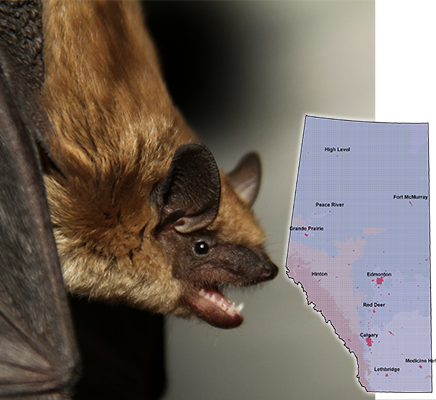
Big Brown Bat
(Eptesicus fuscus)
The Big Brown Bat is one of the larger bats in the province, typically weighing between 15-20 grams. This bat has a broad head and fur ranges from pale to dark brown. Unlike other brown coloured bats, Big Brown Bats have swollen-looking sides to their nose which may help identify them in photos where size is often hard to determine. They are common throughout the southern half of Alberta (including Edmonton), and are one of the most common bats around agricultural communities. Their range is sporadic in the boreal regions, but have potential to occur anywhere in the province. Big Brown Bats are a common resident of prairie river valleys, and a few have been confirmed to hibernate in deep rock cracks and erosion holes along these rivers. They are the only species in Alberta that are known to hibernate in buildings, although it is unknown how often this occurs. Individuals of this species may be active on warm winter days, and may be detected flying outside their hibernaculum.
Big Brown Bats roost in buildings as well as in trees, rock crevices, caves, and mines. Colonies typically consist of fewer than 100 individuals, but sometimes reach several hundred individuals. Colonies tend to be larger in the southern portions of the province, where up to 100 individuals are common. Big Brown Bats have strong jaws, and are one of the most likely species to eat beetles, but diets are variable depending on what is available in their environment.
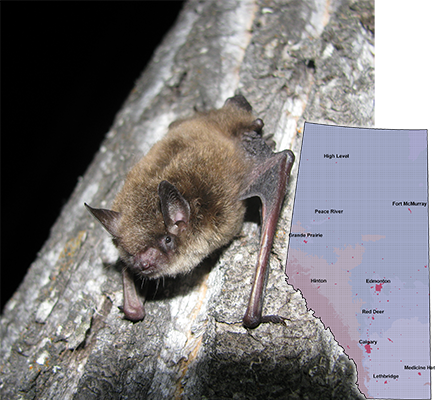
Little Brown Myotis (Bat)
(Myotis lucifugus)
The Little Brown Myotis, also called the Little Brown Bat, is the most common species found throughout Alberta. They commonly roost in buildings, in groups ranging anywhere from a couple individuals up to over a thousand individuals. Other common roost structures include old trees, rock-crevices, caves, mines, bridges, and bat houses. This bat weighs about 8 or 9 grams (about half the weight of Big Brown Bats). Like many bats, their fur is a medium brown colour, although some individuals in southern Alberta may have very pale brown coloured fur. They appear similar to Big Brown Bats but are much smaller.
The Little Brown Myotis eats aquatic insects such as midges, caddisflies and mayflies as well as beetles, moths, mosquitoes, spiders, and various types of flies. They are a common occupant of cottages and other buildings that occur near water. This species has recently been listed as federally Endangered in Canada due to the devastating impacts of white-nose syndrome in parts of North America.
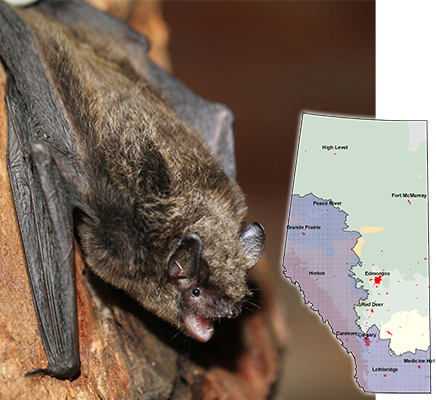
Long-legged Myotis
(Myotis volans)
The Long-legged Myotis is approximately the same size as the Little Brown Myotis and has a similar physical appearance. They may roost in mixed groups with Little Brown Myotis, and may be overlooked in many regions. Recent advances in DNA testing now make it possible to increase the number of reports for this species, but their use of buildings is still poorly understood. Building roosts have been reported in the rocky mountains and foothills, and the use of buildings may be common in some areas. The typical size of colonies is unknown, but a maternity roost in Jasper was found to have over 100 individuals. They are also known to roost under slabs of rock along cliff faces, and may also roost in trees. Long-legged Myotis may be more likely to forage away from wetlands than Little Brown Myotis, where they may target moths rather than aquatic insects.
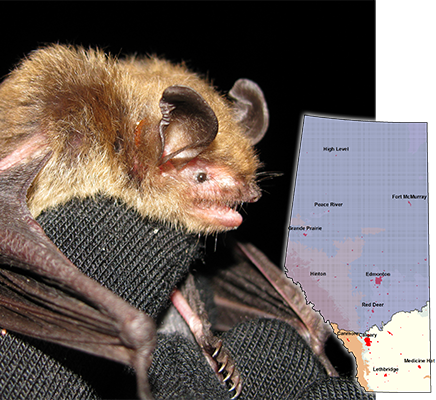
Northern Myotis
(Myotis septentrionalis)
The Northern Myotis is superficially similar to the Little Brown Myotis, but is slightly smaller, has longer ears, a more pointed tragus (a projection in front of the ear canal), and typically has a more pale complexion. They are slightly larger, and have paler fur, and shorter ears than the Long-eared Myotis. Northern Myotis are residents of the boreal forest, foothills and mountains, typically coinciding with regions of the province where Long-eared Myotis do not occur (although their range along the Rocky Mountains is poorly delineated).
Northern Myotis are better able to hunt close to vegetation than the Little Brown Myotis (with which they share most of their range). They forage by gleaning insects that rest on the surfaces of vegetation, often in the understory of old forest. Mothers give birth to a single pup, and maternity colonies can be up to at least 29 individuals. Roosting typically occurs in the crevices of old, large decaying trees (both living and dead), often using deciduous trees such as Aspen or Balsam Poplar.
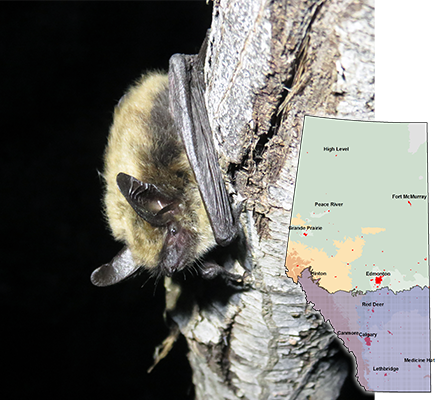
Long-eared Myotis
(Myotis evotis)
The Long-eared Myotis is the second smallest bat in Alberta. They have a dark complexion and especially long ears (about 18 millimetres long), but without close inspection may look similar to the other Myotis species in the province. They are particularly maneuverable, and well adapted to slow flight. This ability appears to allow them to occupy roosts that are close to the ground, such as in erosion holes, tree stumps, under rock piles, and in boulders and other rock crevices. They often glean moths and other insects from the surfaces of vegetation, allowing them to capture sedentary insects, and forage in conditions where cold temperature limits the availability of flying insects.
Long-eared Myotis are common residents of prairie river valleys, especially in the badlands, where they may roost in locations such as sandstone boulders, rock crevices, or erosion holes. They are also common in the mountains, where they have been observed roosting among the scree of rocky slopes. Roosts have occasionally been reported in buildings, but groups are generally small, making them more likely to go unnoticed. Mothers either roost alone or with 1 or 2 other individuals. Larger groups are possible, especially in buildings, where groups of up to 20 individuals have been observed.
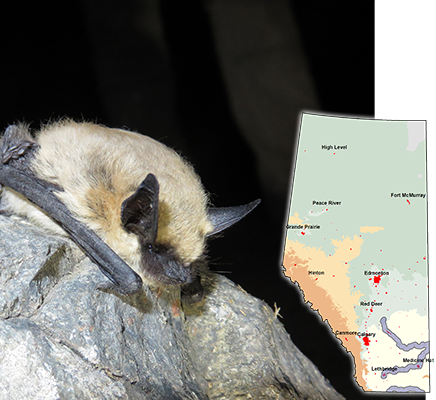
Western Small-footed Myotis
(Myotis ciliolabrum)
The Western Small-footed Myotis is the smallest bat in Alberta, weighing only about 5 grams and is about the size of a thumb. Fur is typically blonde, and their dark skin gives them the appearance of having a black mask. They occupy a variety of arid and semi-arid habitats in western North America and Mexico, but in Alberta they are believed to only occur in riparian badland habitat — in particular, along the Milk River, South Saskatchewan River, and Red Deer River. Other river systems in Alberta with badland/eroded topography also have potential to be used. Their narrow range in Alberta makes them particularly sensitive to habitat loss.
They roost primarily in rock crevices and mudstone erosion holes in Alberta. However, they appear to rely on riparian cottonwood forests as high-quality foraging habitat. They eat a variety of small-bodied insects, such as small moths and flies (including mosquitoes and midges).
They roost in matrilineal family groups (i.e., related through common ancestry on their mothers side), which range from 2 to 35 individuals (more often 2-5 individuals). These groups show high fidelity to specific regions of a river system, which may only span a little over 100 metres. Therefore, the loss of a relatively small area of habitat may displace an entire multi-generational lineage of small-footed bats
Photo credit: All species profile pictures by Cory Olson
